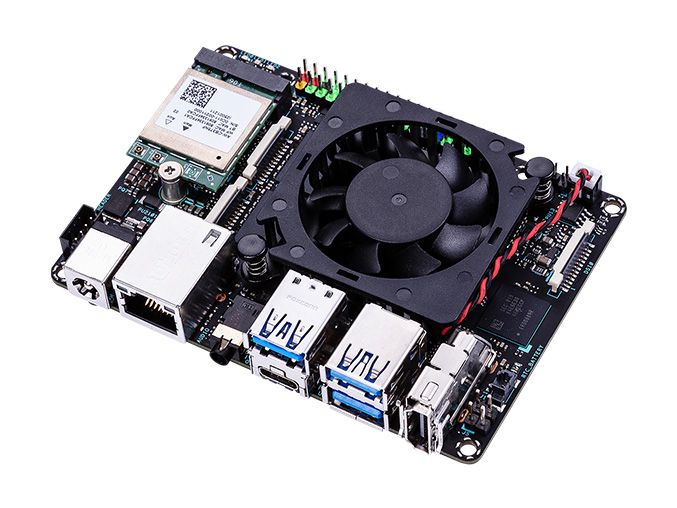
Single-board computer for AI applications, with Rockchip NPU and Arm® big.LITTLE architecture, advanced power design and easy machine-learning model deployment
- Made for machine learning: Powered Rockchip neural processing unit (NPU) with hex-core Arm® big.LITTLE A72+A53 architecture
- Stacked with connectivity: Rich I/O interface, including one MIPI-DSI, two MIPI-CSI, one 40-pin GPIO and a PCIe Mini expansion slot
- Stable power delivery: Flexible 12-19 V DC input, via either a DC jack or a 4-pin header, to provide up to 65 W
- Multiple OS support and dev tools: Both Linux and Android options supported, plus robust API and SDK for developers
TAIPEI, Taiwan, April 29, 2020 — ASUS today announced Tinker Edge R, a single-board computer (SBC) specially designed for AI applications. It has Rockchip RK3399Pro SoC that is equipped with NPU (neural-network processing unit), a machine-learning (ML) accelerator that speeds up processing efficiency, lowers power demands and makes it easier to build connected devices and intelligent applications.
With this integrated ML accelerator, Tinker Edge R can perform up-to 3 Tera Operations Per Seconds (TOPS), using low power consumption.
It also features an optimized neural-network (NN) architecture, which means Tinker Edge R can support multiple ML frameworks and allow lots of common ML models to be compiled and run easily.
Advanced power design
Most SBC motherboards offer only a 15-watt (5V 3A) power design, which can cause device and system instability when there are multiple connected devices. Other SBCs have power designs that lower the performance of their I/O ports. Tinker Edge R has a special power design that, together with both a DC jack input and a 4-pin header, delivers up to 65 watts of power, enabling stable system operation and full I/O performance — even with multiple connected devices. Additionally, an exclusive power-protection design activates automatically if the supplied current and voltage change significantly, effectively protecting the board and all connected devices.
Rockchip RK3399Pro processor
With its powerful and modern hex-core Rockchip RK3399Pro processor powered by Arm® big.LITTLE A72+A53 technology, Tinker Edge R offers a powerful solution for graphics, machine vision, video, audio, voice and safety-critical applications. Tinker Edge R features 4 GB of dual-channel LPDDR4 system memory, the 4th generation of low-power DDR DRAM technology, offering faster speeds and even lower power consumption for improved system performance and efficiency. It also boasts 2 GB of standalone memory for the NPU, delivering faster speeds, improved stability and high efficiency for ML inference.
Tinker Edge R also comes equipped with an onboard 16 GB eMMC and SD 3.0 interface that offers significantly faster read and write speeds for the operating system, applications and file storage.
More connectivity options for developers
Tinker Edge R features a rich I/O interface, including one MIPI-DSI connection for displays and touch screens, and two MIPI-CSI connections for compatible cameras to enable computer vision for applications such as depth measurement, smart-vending-machines and interactive advertising.
A developer-friendly design offers many carefully considered features to provide a superior experience for first-time builders and seasoned hobbyists alike. Programmable LEDs let developers develop custom lighting behaviors, such as system notifications and status indicators, and the color-coded GPIO header makes it easy to recognize respective pin headers.
Tinker Edge R also boasts a full-size HDMI port, USB Type-A, USB Type-C, gigabit LAN and Wi-Fi and Bluetooth for internet and network connectivity as well as a mini PCI Express® Mini slot for a 4G/LTE extension card.
Multiple OS support and machine-learning developer tools
Tinker OS is a great starting point for any project or build and offers operating system (OS) freedom. A Debian-based Linux distribution ensures a smooth and functional experience. Tinker Edge R also support the Android OS: this allows for an entirely different set of usage scenarios, ranging from running popular Android app, machine-learning (ML) inference and much more.
ASUS provides a robust API and SDK that enables users to deploy ML models to Tinker Edge R easily for applications such as image classification and object detection. It also supports model conversion from Caffe, TensorFlow, TensorFlow Lite, ONNX, Darknet and more.
AVAILABILITY & PRICING
ASUS Tinker Edge R will be available from DATE in COUNTRIES from PLACES. Please contact your local ASUS representative for further information.
